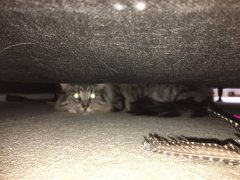
Has your cat ever turned to hiss or bite you when you’re in the middle of petting them? Petting aggression is the most common type of aggressive behavior seen in cats, and most cat owners have experienced this at some point. It’s a cat’s way of telling you they’ve had enough.
But for some cats, this can escalate further, with owners frequently finding that their cat turns to bite the hand petting them. In some cases, this can cause injury or become a concerning problem.
Petting aggression occurs when a cat suddenly hisses or bites during petting sessions. Petting aggression occurs when cats are poorly socialized, painful, stressed, or frightened.
You can overcome aggression with positive reinforcement and desensitization.Key Takeaways
If your cat is suffering from petting aggression, you aren’t alone. It can be frustrating and frightening, but once you have identified the cause of your cat’s behavior you can learn to manage it.
What Is Petting Aggression?

Some cats react aggressively when they have reached their personal threshold of stimulation from petting.
Petting-induced aggression and overstimulation aggression are unwanted aggressive behaviors that occur when a cat is being petted. Cats are highly independent animals, and although they need and benefit from human contact, they don’t need or like as much social interaction as dogs.
Petting is outside of cats’ natural behaviors, but domestic cats have learned to understand it as a display of love and affection from their owners.
There are several types of aggression in cats, including fear aggression, territorial aggression, maternal aggression, and play aggression, as well as petting aggression.
The sensitivity threshold is the point when a cat has had enough of being petted, and every cat’s threshold is different. They might enjoy being stroked for a few minutes but eventually, the repetition becomes annoying, and your cat will let you know they’ve reached their limit.
At this point, some cats will just get up and move away, others might turn and hiss, or others will appear to scratch or bite with no warning.
Also Read: How To Deal With Food Aggression In Cats
Causes of Petting Aggression
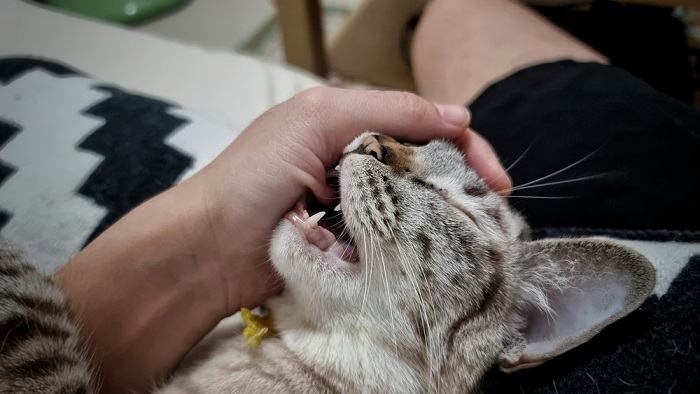
Pain, stress, and your response to their behavior can increase the likelihood of petting aggression.
Petting aggression has several causes. It can stem from incorrect handling of young cats, poor socialization, or not being familiar with physical contact with humans.
Feral cats that are rescued and taken into homes are often less tolerant of petting due to their lack of human contact as kittens, they simply haven’t learned that human contact can be pleasurable. Cats rescued from abusive situations might fear human contact as they associate it with trauma.
- Pain can cause cats to become aggressive. This can happen if you touch or stroke the painful area, or simply as their way of saying don’t touch me I don’t feel well. Pain could be caused by conditions such as arthritis, soft tissue injuries, abdominal pain, or dental disease, or they might feel uncomfortable because they have a fever. Skin conditions can also make stroking uncomfortable for cats.
- If your cat is feeling stressed by changes in their environment, they might be a bit more on edge and less tolerant of petting. Boredom can also trigger aggression in cats. If they are not getting enough exercise or stimulation, they can become agitated and less tolerant of human interaction.
- The way you respond to your cat’s aggression can influence the condition. Negative responses to a bite or scratch can make your cat fearful by reinforcing the behavior. This is known as conflict behavior, as your punishment might add to an existing problem.
Also Read: 12 Warning Signs Your Cat Is In Pain And Crying For Help
Signs of Petting Aggression
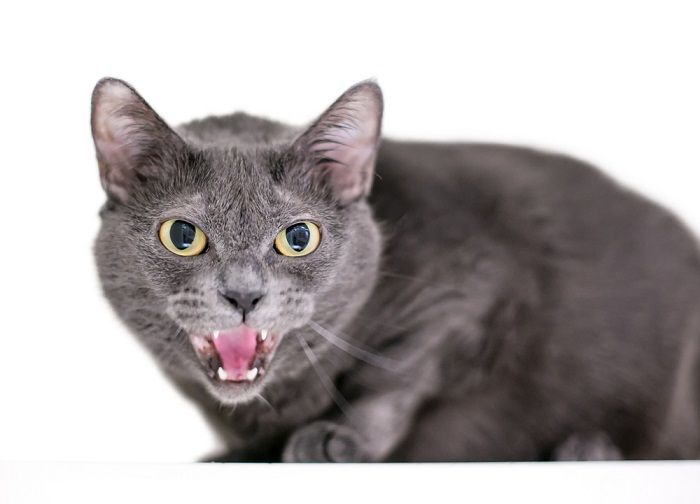
Often cats will give no warning signs that they are about to turn on you. But you can tell a lot from your cat’s body language. Subtle signals might let you know that your cat is uncomfortable in the situation. Some common signs of irritation to watch out for include:
- Tail twitching or swishing
- Ears down
- Dilated pupils
- Increased heart rate
- Skin twitching
- Body tensing
- Growling or hissing
- Turning the head
- Scratching
- Biting
All cats will occasionally be intolerant to petting, but for cats suffering from petting aggression, these signs will be apparent almost every time you pet your cat.
Also Read: Why Does My Cat Hiss at My Partner?
How To Stop Petting Aggression
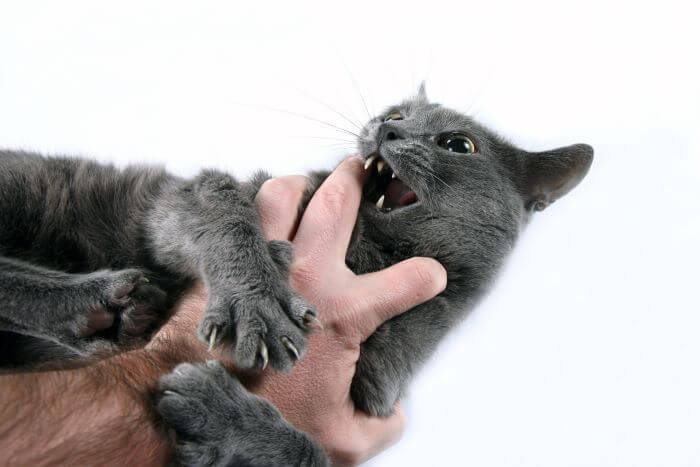
Schedule a checkup with the vet to make sure the petting aggression isn’t due to pain or another medical issue.
If you’re concerned about your cat’s aggression, the first thing to do is speak to your veterinarian. It’s important to rule out medical causes for your cat’s behavior, so your vet will want to examine your cat, and might need to run some tests to rule out any medical problems.
If any health problems are found, these can be treated, which often is enough to improve your cat’s behavior once they are feeling better. You can also seek advice from a veterinary behaviorist.
1. Desensitization
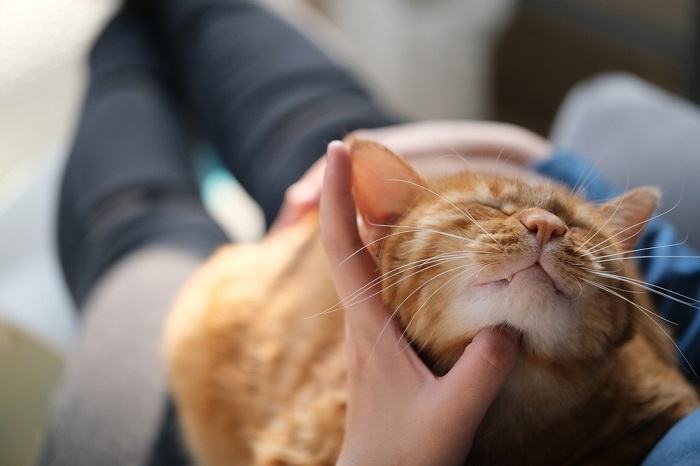
To acclimate your cat to more petting, stop after a stroke or two, and slowly build up the duration.
It is possible to desensitize your cat to improve their tolerance to human interaction and petting. This involves rewards, time, and patience but it can be very successful. For example, if your cat will tolerate two strokes, add a third stroke then reward them with a treat.
Then leave your cat alone before they get a chance to turn on you. Slowly adding one stroke a week will increase their tolerance and stop them from biting.
Also Read: How To Pet A Cat – The 3 Basic Do’s And Don’t’s
2. Use Positive Reinforcement
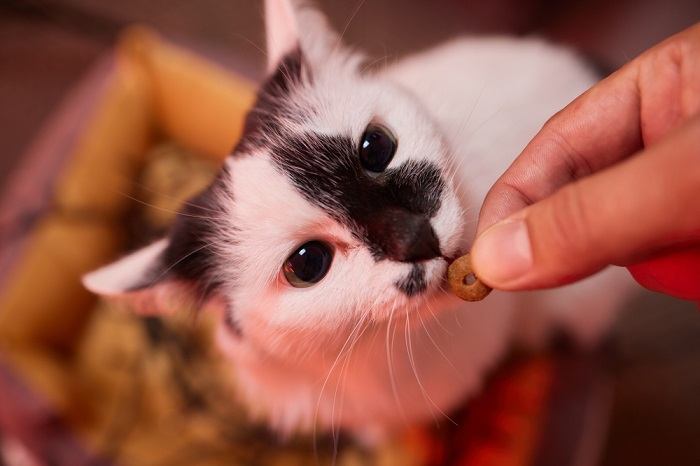
Try rewarding your cat with treats when they accept petting without aggression.
When it comes to training cats, never use negative or physical punishment—this will only lead to your cat becoming fearful of you and can even affect the bond between you in the long term. Cats struggle to associate negative punishment with what they have done, rather they associate with you as something you did to them.
Instead, use positive reinforcement to reward your cat for good behavior. Using high-value food rewards, or a game with their favorite toy to let them know they’ve been good. It is possible to clicker train cats, so they associate the clicking sound with a reward. This can be a very useful tool for overcoming aggression and desensitizing cats to petting.
Also Read: The 7 Best Cat Treats For Training
3. Change the Way You Pet Your Cat
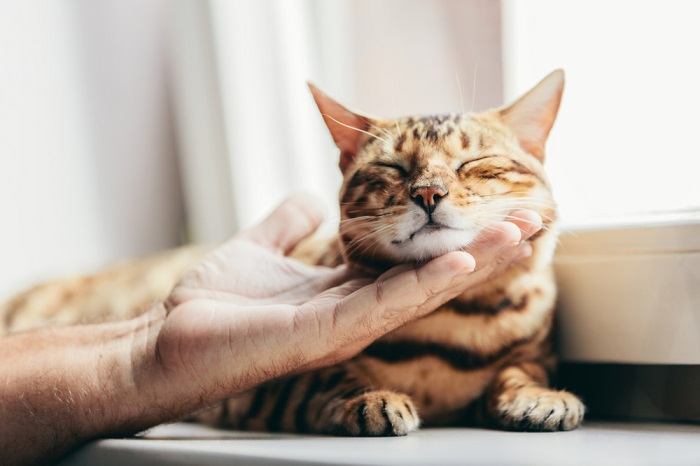
All cats prefer to be touched differently, so take the time to find out what your cat likes.
It’s important to learn how to pet your cat, as every cat is different. Get to know what they do and don’t like—some cats prefer smaller and shorter strokes, others only like their body stroked, and some tolerate a belly rub.
Start slowly in an area you know your cat likes such as the cheeks or under the chin and let them come to you and rub their face and body around you. Avoid petting your cat while they are eating, sleeping, or playing as they are likely to be irritated by this.
Also Read: What Does It Mean When A Cat Rubs Against You?
4. Create a Relaxed Environment
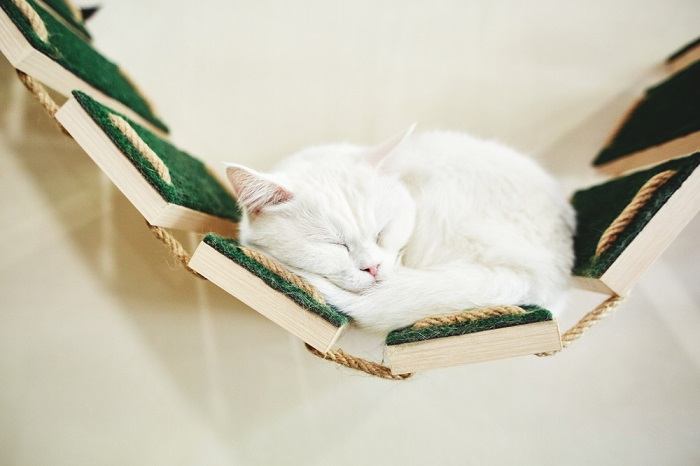
The more relaxed your cat is, the more open they will be to gentle petting.
If your cat is stressed or anxious, you can help them to relax by creating a calm environment at home. Make sure your cat has plenty of its own safe spaces to rest and hide such as beds and blankets.
Synthetic pheromone diffusers and sprays such as Feliway can help your cat relax, too. If your cat is stressed by a new pet or visitors to the house, make sure your cat has a safe space to escape to where they can relax and feel secure.
Also Read: What Are Cat Pheromones And Do They Really Work?
5. Provide More Enrichment and Stimulation for Your Cat

Pent-up energy and boredom can sometimes cause cats to lash out during petting sessions.
Sometimes overstimulation or petting-induced aggression is down to boredom and frustration. Make sure you keep your cat physically and mentally stimulated with plenty of playtime.
Let your cat enjoy time outdoors if you have access to safe outdoor spaces and have plenty of toys and scratching posts indoors. Increasing playtime and burning off energy can overcome problems with your cat’s sensitivity threshold.
Also Read: 8 Purrfect Games You Can Play With Your Cat
Petting Aggression: Final Thoughts
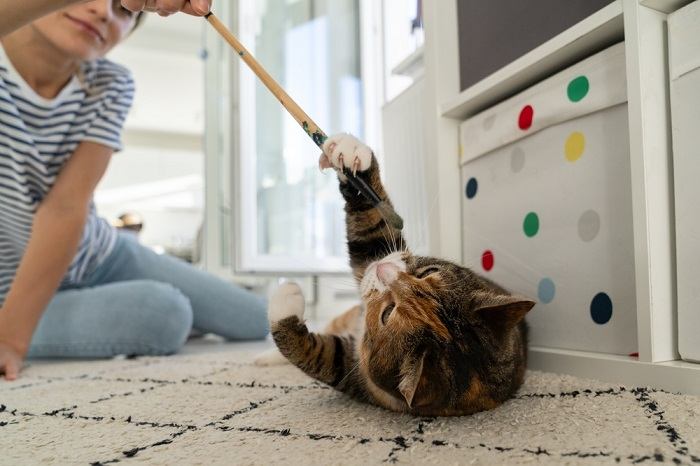
If your cat bites you, always consult with a medical doctor as cat bite can cause severe infections.
Petting aggression is a concerning and frustrating problem faced by many cat owners. It can be caused by a number of health problems as well as environmental factors, and it’s important to identify these to understand how to manage the problem. Always get your cat checked over by a vet to rule out and treat any medical problems and use positive reinforcement and desensitization to help your cat overcome their fears.
It’s vital to note that if your cat bites you, you must wash the area thoroughly with soap and water, and then seek advice from a medical professional, as cat bites can cause nasty infections.
Also Read: Are My Cats Playing Or Fighting?
Frequently Asked Questions
How do you stop petting aggression in cats?
Petting aggression can be overcome by desensitization, positive reinforcement, removing stress, or treating pain. It takes time and patience to overcome.
How do I desensitize my cat to petting?
You can desensitize your cat to petting by stroking them a couple of times and adding another stroke if they tolerate it. Then reward them and let them get back to their own devices before they can become aggressive. Each week, add an extra stroke to increase their tolerance.
How do you punish a cat for aggression?
Never punish your cat for aggression as this can reinforce the problem, as well as make them fearful of you. You should use positive reinforcement, rewards, and desensitization instead.

